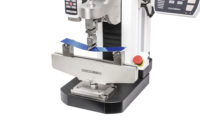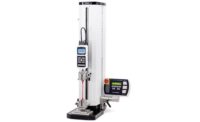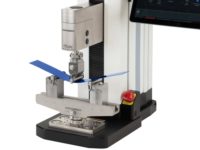The decision to purchase a piece of measuring equipment should never be taken lightly. Whether procuring a drop indicator or a multi-million dollar coordinate measuring machine requiring several signatures of approval, the result of a quality control measurement can only be as good as the equipment used to perform it. Reflexively seeking the lowest price or a familiar model number should be resisted until a thorough assessment of the quality testing challenge and available solutions has taken place. This couldn’t be more true than when purchasing equipment to measure the amount of force required to break, tear, actuate, or otherwise achieve a quality control objective with regards to the mechanical properties of a material or a part.
Why rethink force measurement?
Force measurement refers to the measurement of a compression or tensile force. Closely related but not to be confused with weighing and materials testing, industry is rife with applications for force measurement. Typical examples include determining packaging seal strength, wire terminal removal, switch activation, and spring forces. The most familiar embodiment of force measurement—the ubiquitous force gage—had its origins many decades ago. Having evolved from a simple spring weighing scale, the handheld force gage of today can be as accurate and advanced as a closet-sized tensile testing machine from years ago.
Force gages today are joined by test stands which have also grown in sophistication. Usually, a screw-driven crosshead moves a force gage up and down to produce a force, and reverses when the test is complete. A test stand’s controller can regulate the rate of speed, stop the motor when a specified load, distance, or sample break has occurred, cycle the crosshead, and accept commands from a PC. Much like innovation in personal computing has progressed rapidly, so too has the ability of force measurement systems to provide useful and cost-effective answers to quality control questions. These answers have upended previously held notions about what a tensile or compression testing apparatus must look like.
Determining whether force measurement equipment can help the quality control engineer or researcher satisfy an ISO, ASTM, or internally developed standard starts with a thorough inspection of the requirements of the standard. Consider some of the core parameters typical of a standard testing procedure:
- Accuracy and resolution of the measuring instrument
- Unit of measurement
- Proper sample preparation and dimensions
- Linear speed of the testing apparatus
- Nature of the sample gripper or fixture
- Requirement for force measurement only or force vs. displacement
- Interpretation and storage of results
When comparing these parameters to the capabilities of a force measuring instrument, it may become evident in many applications that a system consisting of a test stand, force gage, suitable grips, and data collection software can satisfy the application.
A motorized test stand can be programmed to run at a specified rate of speed and can be fitted with an internal scale for displacement measurement. The force gage can display peak and real time values with an internationally accepted level of accuracy, and numerous standard grips and fixtures are readily available. In many cases, custom fixtures are fabricated to reflect the great variety of sample shapes and sizes.
Data collection software captures peak readings or continuous force readings for force vs. time or force vs. displacement tabulation and plotting. Statistical calculations, exporting, and reporting tools are commonly available in basic software packages. In simpler applications, a printer can be used to print the results and basic statistics. Some test stands can be controlled by PC software to help reduce operator influence, increase testing throughput, and improve data collection.
In OEM type applications, force measurement can be a viable alternative to analog data acquisition systems. A force gage can become an integral component by interfacing the gage’s set point, digital, footswitch, and analog inputs/outputs with a programmable logic controller (PLC). One example involves an electronics manufacturer joining two parts with an adhesive. For proper setting of the adhesive, a specified force is required for a specified period of time. The gage is monitored in order to stop the customer’s press when the force has been reached. Another application involves integrating a force gage into a suture pull testing machine, for use at the medical device production facility.
Test stand-based systems can also be integrated into complete systems, for example as a test station in a wire harness production line. Serial communications between the test stand, force gage, and PLC can automatically run the stand, collect data, and stop the production line if a non-conforming sample has been detected.
Calibration can be a simple process. Typically the only part of a force measurement system requiring calibration is the force gage itself. When it is due, it is removed from the test stand and transported to the laboratory, where deadweights or a master load cell is used to calibrate to full scale and several points in between. It is, therefore, not necessary for the calibration technician to travel to the test station to calibrate it.
When does force measurement take a back seat?
Throughout these examples, force measuring instruments were used in cases where, in the past, a more expensive alternative may have been the default choice. However, despite technological advancements, materials testing takes over from where force measurement leaves off. Materials testing uncovers a wealth of scientific information about the mechanical properties of a material, component, or assembly, and has been invaluable to industry, research, and educational institutions. Through a combination of sophisticated software and measurement of very small deflections, material testers have earned their place in quality control laboratories throughout the world.
Force measurement systems’ deflection measurement accuracy and resolution are typically too coarse for reliable measurements, which means that applications such as tensile testing of steel and compression testing of stiff spring washers become challenging. In such cases, a materials tester fitted with extensometer and analysis software is essential. Such software can capture a stress vs. strain curve to help characterize materials and automatically identify important features such as Young’s Modulus and yield strength. For more specialized applications requiring the calculation of industry-specific coefficients, materials testing software is often capable of providing such results.
With sophistication comes a learning curve, which is why materials testers have traditionally been used by trained professionals in a laboratory type environment. Force measurement equipment cannot replace a materials tester, but typically has a simpler interface, reflecting its more focused capabilities. For many companies, there is a need for force measurement equipment and materials testing equipment to coexist—perhaps a materials tester to test incoming raw materials, and a force measurement system to measure a finished component or assembly.
The bottom line
In today’s competitive manufacturing environment, it has become more important to carefully analyze test applications and the capabilities of available instrumentation. Educating oneself about the capabilities and limitations of force measurement equipment can better guide procurement decisions. Optimizing such decisions can translate into decreased equipment and maintenance costs, reduced operator training time, and faster throughput.
|
TECH TIPS
|






